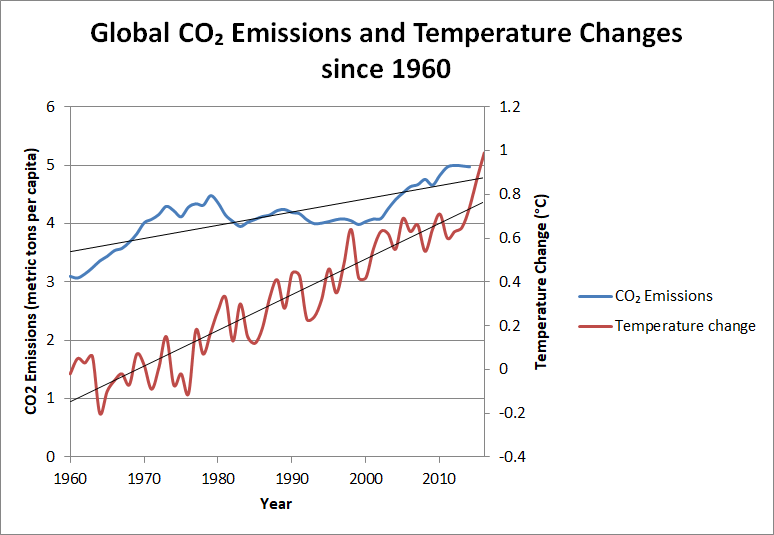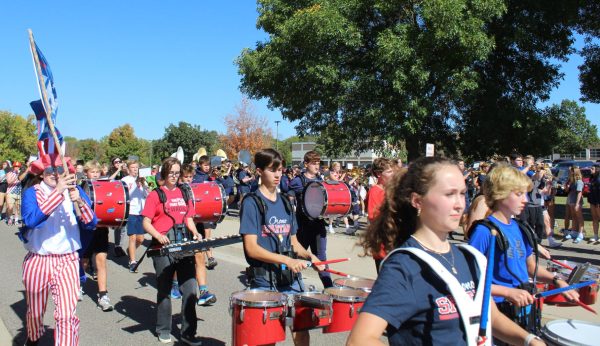Climate change affecting autumnal migrations
Graph demonstrating changes in carbon dioxide emissions and global temperature. Data taken from NASA and The World Bank.
As autumn moves into Minnesota and the weather changes, animals get their cues to start preparing for hibernation or migration south. As global temperatures rise, however, the animals’ fine temperature receptors can’t adapt quickly enough to the changes, sometimes causing them problems with migrations and survival, among other issues.
The world’s average surface temperature has increased from .8° C from 1880, with two-thirds of this change happening after 1975, according to NASA. While this may not look significant, it’s important to realize that it takes a lot of energy to warm all of the bodies of water on the planet by one degree. This is because water has a high specific heat: it takes 4.184 Joules to raise one gram of water 1° C. It only took a couple of degrees below average to plunge the world into an ice age, according to NASA.
This global temperature shift has affected autumn and animal migratory patterns around the world. Some of the countries most affected by this are Canada and Russia, as the most dramatic temperature shifts have been occurring there. For example, caribou in Canada migrate to small pockets of vegetation to feed and raise their calves. However, the shift in temperatures means that their main food source has already gone to seed when they arrive, according to the David Suzuki Foundation.
Other species and habitats that have been hard hit are tundra, arctic and antarctic habitats. Global ice cap melting has caused global ocean levels to rise 20 centimeters (eight inches) since 1901. Birds such as the snowy owl may have problems, since an important prey of theirs, collared lemmings, may lose 60 percent of their habitat, according to the David Suzuki Foundation.
Freshman Jake Larson said he noticed other birds having their own problems as well. “Normally around this time of year I usually see a lot more trumpeter swans and geese flying by, but I’ve only seen three or four of these birds flying. It’s definitely a lot different,” Larson said.
Some people have already started to see changes in Minnesota. “I feel like when I was younger it used to be colder. I remember in October, during Halloween, sometimes it would be snowing, and I feel like now that doesn’t happen as often anymore. I feel like it’s warmer,” senior Elizabeth Hauff said.
Animals are affected by the weather in several ways. “With the warmer climate … migratory animals are not migrating at all, or they’re not migrating as far because they don’t have to go as far to escape the harsh conditions,” science teacher Jeremy Buch said, “All that puts a strain on the vegetation where [they]—especially if they’re herbivores—spend their summers. They’re staying there longer, and they’re showing up earlier.”
While many species have been having issues as a result of climate change, some can and do thrive. Species affected positively by this include invasive species and weeds. The warmer weather allows them to spread further, taking over native species and plants that are being hindered by the changes. Species that already have a hard time fighting spread of invasive ones may have a more difficult time as their natural habitat vanishes.
Those with incredibly small and specified habitats will be devastated the most by the shift in temperatures. “There’s the black tailed deer that are in the cold rainforests in Oregon, Washington, and Vancouver, British Columbia. Those animals have a very small habitat that they can thrive in, and as climate changes…their habitat is going to change and shrink,” Buch said.
Other problems visible in autumn because of climate change include, but are not limited to, a later “ice up” – when the lakes finally freeze – milder temperatures, and larger differences in usual precipitation. While September was extremely rainy, this winter could easily go between the extremes of having too much or too little snow.























































